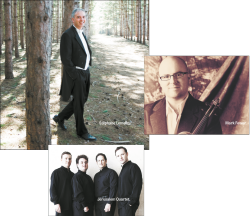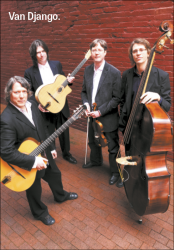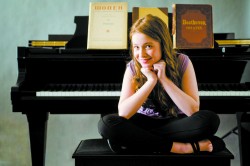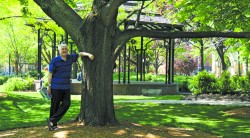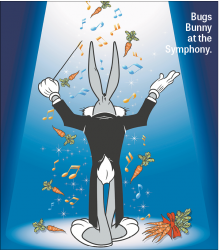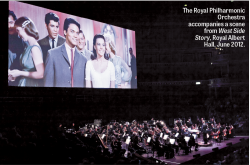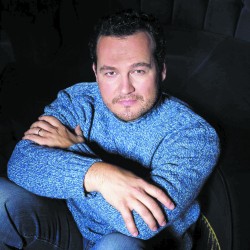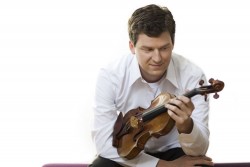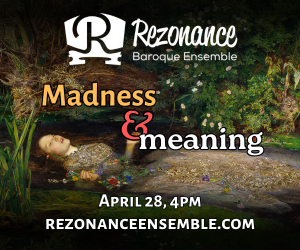Let’s Hear It for the Women!
A quick glance at last month’s column could lead a person to conclude (erroneously) that there were only men making music on the “classical and beyond” scene. If, as the old adage goes, a picture — in this case more than one — is worth a thousand words, then, indeed, we (inadvertently) told a skewed story.
So, dear readers, I intend to rectify the picture with this, my last installment, after two years on the Classical & Beyond beat.
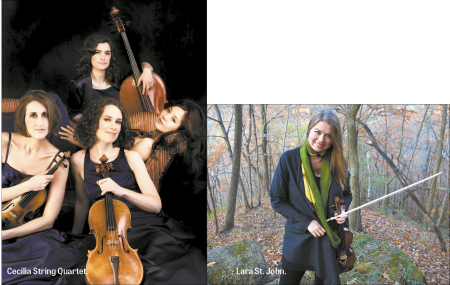 Of saints and season starters: And what better way to do so than to start things off with concerts featuring the Cecilia String Quartet (CSQ) — four formidably talented women whose namesake is none other than that patroness of musicians, herself, Saint Cecilia. Apparently it was the group’s coach at the time, Terry Helmer, who suggested “Cecilia” and the name stuck. While the quartet’s cellist, Rachel Desoer, “confesses” that the saint connection isn’t all that important to them, she does admit that “it is a fun bit of trivia.”
Of saints and season starters: And what better way to do so than to start things off with concerts featuring the Cecilia String Quartet (CSQ) — four formidably talented women whose namesake is none other than that patroness of musicians, herself, Saint Cecilia. Apparently it was the group’s coach at the time, Terry Helmer, who suggested “Cecilia” and the name stuck. While the quartet’s cellist, Rachel Desoer, “confesses” that the saint connection isn’t all that important to them, she does admit that “it is a fun bit of trivia.”
Asked about when the group gelled, founding violist, Caitlin Boyle, says that “at the very first rehearsal [in 2004, when the original CSQ members met as classmates in the University of Toronto’s Faculty of Music chamber music program] there was a sense that there was a very dynamic chemistry to our group, and it felt like we just ‘clicked.’ After that, many things just fell into place, and we were fortunate that the many opportunities that came our way led us down this magical quartet path.”
Currently ensemble-in-residence at U of T, the much-lauded CSQ launches Mooredale Concerts’ 25th season — Bravo, Mooredale! — on October 6, with two concerts at Walter Hall. The first, Mooredale’s always entertaining and educational series, Music & Truffles, offers an early afternoon interactive concert for young audiences ages 6 to 15. The second, starting two hours later at 3:15pm, is the extended concert Mooredale presents to its more adult patrons. These concerts will also mark the CSQ’s first Mooredale Concerts appearance, though violinist Min-Jeong Koh tells me that both she and fellow CSQ violinist, Sarah Nematallah, have played on the series several times over the years and that Koh also played in the Mooredale Youth Orchestra.
For the 3:15pm concert, the quartet will perform Tchaikovsky’s String Quartet No.1 in D Major Op.11 and Haydn’s Quartet No.4 in D Major Op.20. And then sparks will fly with double the fun, when special guest, the Afiara String Quartet (ASQ) joins the CSQ in Mendelssohn’s splendid and iridescent Octet in E-Flat Major. (For the earlier Music & Truffles concert, the two will perform excerpts from the Octet.)
The two quartets appear to be connected by only two degrees of separation, if that. For starters, the CSQ’s Koh is married to the ASQ’s cellist, Adrian Fung, and the two groups have performed together a number of times. In 2010, the CSQ won first prize at the Banff International String Quartet Competition, with the ASQ coming in second. Closer to home, the CSQ was the first recipient of the Royal Conservatory’s Glenn Gould School Quartet Residency Fellowship in 2010, and the ASQ the second in 2012. They performed the Mendelssohn Octet at the Festival of the Sound this summer and, earlier in the spring, at Stanford University’s Bing Concert Hall during its inaugural season. Interestingly, both quartets were first introduced to the Stanford campus by the university’s resident ensemble, “our” St. Lawrence String Quartet, who, just last month, awarded the CSQ the 2013 John Lad Prize (now in its third year), named in honour of the SLSQ’s dear friend John Lad (Stanford ’74), a violist and ardent chamber music lover who died in 2007.
In presenting the prize, the SLSQ’s violist and co-founder, Lesley Robertson, stated: “This award recognizes the Cecilia Quartet not only for the extraordinary impact this young ensemble has made already on the world’s concert stages but perhaps more significantly for the impact off stage — for their dedication and generous contributions as chamber music ambassadors in the greater community.” Nicely done, CSQ! (I figure the ASQ’s got to be the shoo-in for next year.)
All speculation aside, you can be sure that Mooredale’s 25th anniversary season openers will be a winning combination with these two exceptional quartets!
From Saint to St. and ST: Continuing with this business of “saints” and season launches, powerhouse Canadian-born violinist Lara St. John has been invited by Sinfonia Toronto (ST) to open the ensemble’s 15th season, the evening of October 26, at the George Weston Recital Hall.
Some things never change, and sometimes that’s a good thing. St. John’s first (and only) concert with ST was four years ago, almost exactly to the day (October 23, 2009). John Terauds, former music critic for the Toronto Star and now Toronto’s best-known classical music blogger, interviewed St. John for the Star in 2009, reporting that the program allowed her to “show off her wide-ranging repertoire.” Well, ST music director, Nurhan Arman, has done it again, with a wonderfully varied program that we’re told “dances from Bach to the vivid melodies of Nino Rota,” affording the six-foot-tall St. John significant opportunity to strut her stuff.
A skilled, prolific and thoughtful interpreter of Bach, St. John will perform Bach’s exhilarating and beloved Violin Concerto in E Major and then skip a few centuries to play the North American premiere of Australian composer Matthew Hindson’s evocative Maralinga for violin and string orchestra, which St. John co-commissioned and premiered in 2011. St. John has high praise for Hindson and this work, which she calls an “about-to-be” classic piece: “It was pretty amazing to play a piece called Maralinga in South Australia, for sure ... Every part of the world with such a story [think secret, nasty, nuclear testing] should be so lucky as to have Matthew write a piece about it.”
The program also includes Grieg’s Holberg Suite for string orchestra and Rota’s Concerto for Strings. I asked if she might join the ST in the Rota and her answer was classic St. John: “I think I’ll be leaving the Rota to the fabulous Sinfonia, seeing as I wouldn’t be there for enough rehearsals. Also, I am a terrible sight reader (everyone thinks I am joking until they actually see/hear this, at which point they try to leave the room).”
Other examples of her refreshing candour, humour, energy, passion and intelligence: in July, 2010, St. John was interviewed for an NPR special series titled, “Hey Ladies: Being A Woman Musician Today,” during which a few of her earliest CD covers, deemed by some to be “sexually suggestive,” ended up being the main topic of discussion. Somewhere in the middle, she said, teasingly, “I suppose I could have had a picture of a babbling brook on the front, but what would have been the point?” And toward the end, she simply told it like it was, and is: “Music is all about life and passion and love and death ... And if it takes sexuality to exude that visually, then so be it. It makes more sense for us, as women musicians, to express ourselves any damn way we want.”
St. John also expresses herself, exuberantly, through the record company she founded in 1999, where she gets to call all the shots (any damn way she wants), including naming the company Ancalagon, which I learned (and she confirmed) was in memory of her pet iguana. “Ancalagon, who I named after a dragon from Tolkien’s Silmarillion, died right before I began my company, and I was devastated. So I decided to keep him alive in a way. Now, I have another iguana ... named Cain.”
The woman definitely has a thing for reptiles. Which brings us marching full circle, back to the saints. Turns out, St. John has maintained an online WordPress page for years, under the name “sauriansaint.” And guess what? Saurian, in case you missed that evolutionary biology class, is defined as being “any of a suborder (Sauria) of reptiles including the lizards.”
Here’s a wee taste of some of the titles to her entertaining blog entries: from January 19, 2013, “Variations on ‘Is That a Violin???’”; from October 17, 2011, “Tricks For Getting Your Violin On a Plane”; and from June 7, 2003, “The Grey Plastic Laundry Tubs at Airport Security.” All cheeky and hilarious! (sauriansaint.wordpress.com)
Who wouldn’t want to invite Lara St. John to their gala — with or without her pet iguana? It will be thrilling to see and hear her, as Sinfonia Toronto ushers in its 15th year with grand gusto!
I’d love to fill several more pages with stories of successful women musicians but, unlike St. John, I don’t get to call the shots. For one final time, though, I can leave you with these:
QUICK PICKS
More women (and a few good men) to watch for this month:
Women's Musical Club of Toronto
Oct 17, 1:30: Music in the Afternoon: Bax & Chung, piano duo.
Gallery 345
Oct 18, 8:00: The Art of the Piano: Beatriz Boizan.
Nov 2, 8:00: Leslie Ting, violin, and Sarah Hagen, piano.
University of Toronto Faculty of Music
Oct 26, 7:30: University of Toronto Symphony Orchestra. Bianca Chambul, bassoon.
Oct 31, 12:10: Thursdays at Noon: Debussy and Ravel. Shauna Rolston, cello; Erika Raum, violin; Lydia Wong, piano.
Royal Conservatory
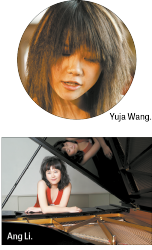 Oct 27, 3:00: Yuja Wang, piano.
Oct 27, 3:00: Yuja Wang, piano.
Nov 3, 2:00: András Schiff, piano.
Kitchener-Waterloo Chamber Music Society
Oct 18, 8:00: Triple Forte Trio. Jasper Wood, violin; David Jalbert, piano; Yegor Dyachkov, cello.
Oct 23, 8:00: Ang Li, piano.
Toronto Symphony Orchestra
Oct 10 and 12, 8:00: Masterworks: James Ehnes, Violin, Plays Britten.
Oct 19, 7:30: Light Classics: From Dvořák to Tchaikovsky. Vilde Frang, violin. Also Oct 20, 3:00.
University of Waterloo Department of Music
Oct 23, 12:30: Noon Hour Concerts: New Canadian Duos.
Stephanie Chua, piano; Véronique Mathieu, violin.
Oct 19, 8:00: Heroic Exploits. Vivian Chon, violin. Also Oct 20 (Richmond Hill).
These last two years as Classical & Beyond columnist have been rich and rewarding. I don’t know that I’m any closer to answering that always-niggling question, “Beyond what?” and that’s okay. Above and beyond all else, the journey toward trying to figure it all out has been a true joy. To the music!
Sharna Searle trained as a musician and lawyer, practised a lot more piano than law and has just wrapped up a three-year stint as listings editor at The WholeNote. Comments on and items of interest for the column should continue to be sent to classicalbeyond@thewholenote.com.


